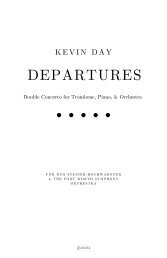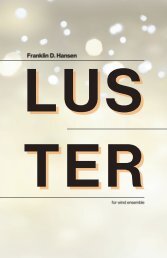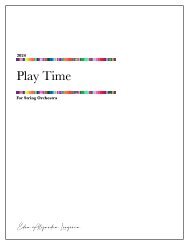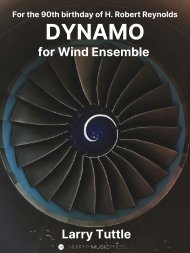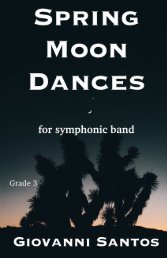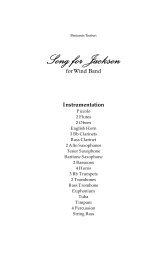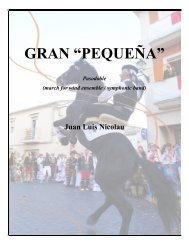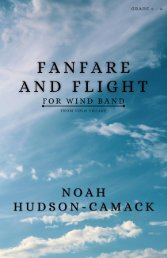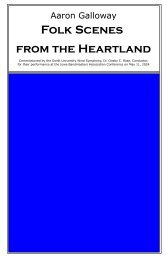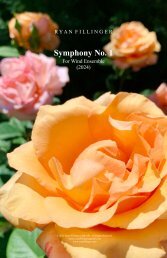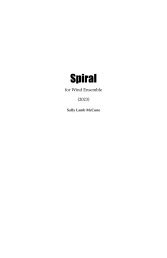Jenkins_We Seven
Create successful ePaper yourself
Turn your PDF publications into a flip-book with our unique Google optimized e-Paper software.
<strong>We</strong> <strong>Seven</strong><br />
for Wind Ensemble<br />
Duration<br />
about 10’00”<br />
Instrumentation<br />
1 Piccolo<br />
2 Flutes<br />
2 Oboes [2° doubles Crystal Glasses]<br />
2 Bassoons<br />
1 Contrabassoon<br />
4 Clarinets (Bb) [3° and 4° double Crystal Glasses]<br />
1 Bass Clarinet<br />
2 Alto Saxophones<br />
1 Tenor Saxophone<br />
1 Baritone Saxophone<br />
4 Trumpets (Bb) (all parts need cup mutes, 4° needs straight mute)<br />
4 Horns (F) (1° needs straight mute)<br />
2 Tenor Trombones (all parts need cup mutes)<br />
1 Bass Trombone (needs cup mute)<br />
1 Euphonium<br />
2 Tubas<br />
1 String Bass<br />
4 Percussion<br />
Percussion I:<br />
Percussion II:<br />
– Marimba – Vibraphone<br />
– Bass Drum – Suspended Cymbal<br />
Percussion III:<br />
Percussion IV:<br />
– 3 Triangles (small, med., large) – Chimes<br />
– Tam-Tam – Crotales<br />
– 2 Suspended Cymbals – Crash Cymbals<br />
Program Notes<br />
<strong>We</strong> <strong>Seven</strong>, the title of this work, comes from a book by the same name written by the U.S.'s first<br />
astronauts. In 1959, the U.S. entered the space race by starting a program whose main aims included<br />
sending a solo astronaut into space and recovering him safely. Project Mercury, as this program was so<br />
called, recruited the first seven American astronauts and successfully sent six of them into space. These<br />
men were Scott Carpenter, Gordon Cooper, John Glenn, Gus Grissom, Wally Schirra, Alan Shepard, and<br />
Deke Slayton, and collectively they became known as the "Mercury <strong>Seven</strong>." Through their efforts and<br />
those of countless others, the U.S. Space Program accomplished much with these six flights, including<br />
successfully sending an astronaut into space, putting a man in orbit, and keeping him up there for more<br />
than 24 hours. In 1962, shortly after Glenn and Carpenter's orbital flights, the "Mercury <strong>Seven</strong>" co-wrote<br />
the book <strong>We</strong> <strong>Seven</strong> and throughout it, the astronauts discuss the events leading from their selection into<br />
the program up through Carpenter's flight in May of 1962. The primary material for the work comes from<br />
two sources: the use of musical cryptograms to encode the astronauts names and initials into pitches and<br />
the aria 'Un bel dì vedremo' from Giacomo Puccini's opera, Madame Butterfly. The inclusion of the latter<br />
comes directly from one of Glenn's chapters in the book. Together with a couple of the other astronauts,<br />
he would often listen to the opera to unwind from a long day of training. I would like to think that as he<br />
was orbiting the Earth that this opera, particularly this aria, would be running through his mind.<br />
This work commemorates the Project Mercury on the 50th anniversary of its conclusion and was written<br />
for Joseph Parisi and the University of Missouri-Kansas City Wind Ensemble.



